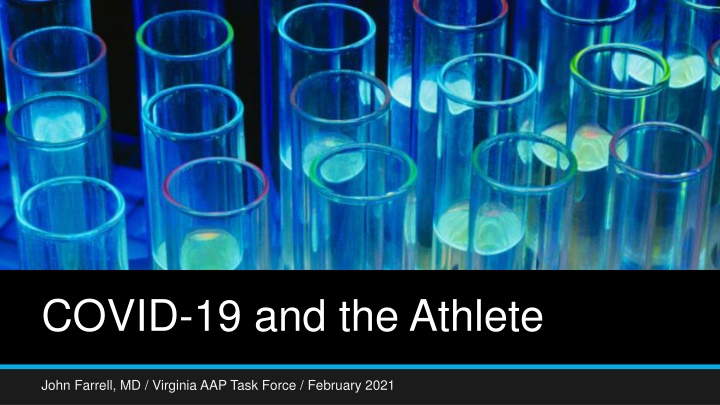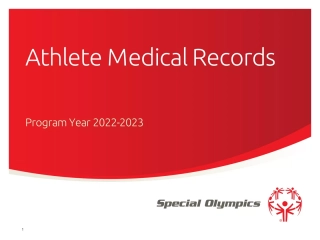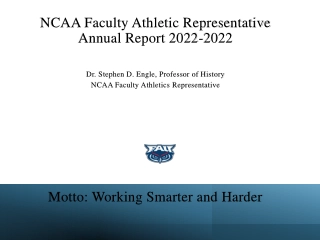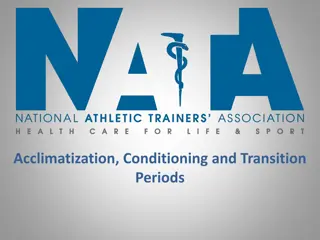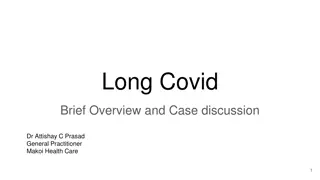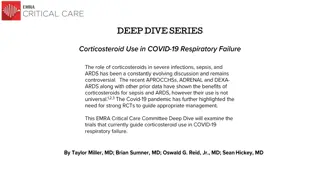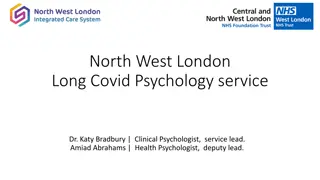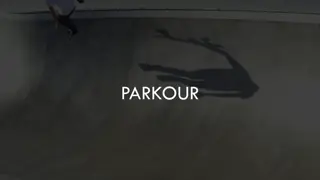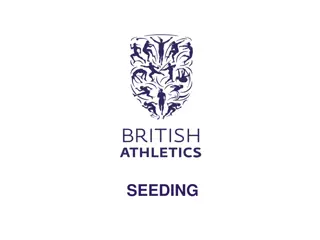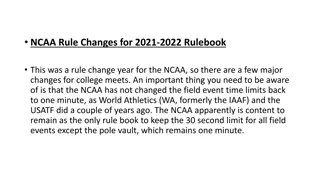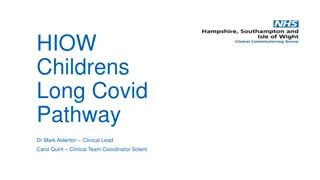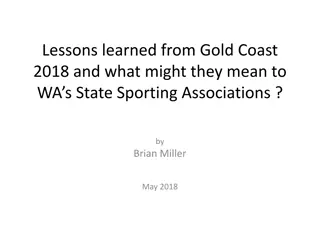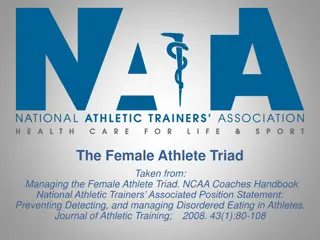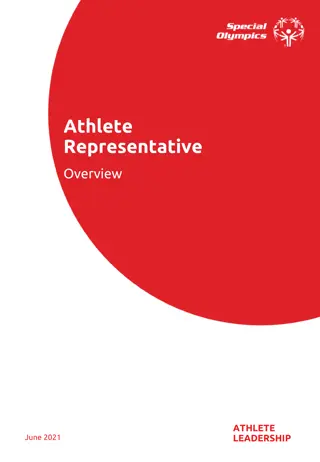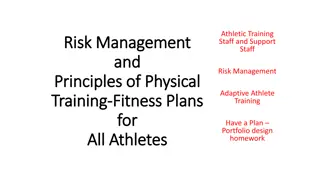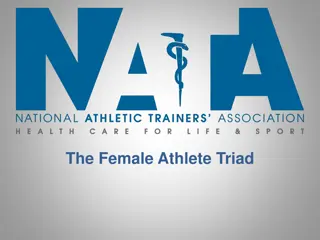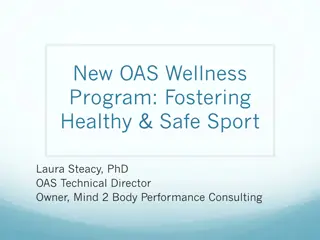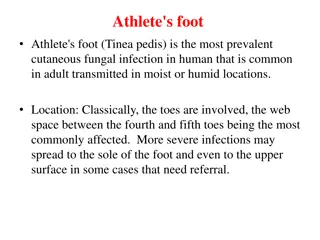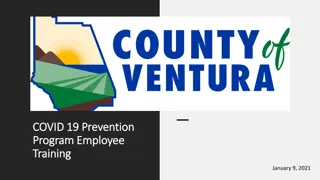COVID-19 and the Athlete
COVID-19 poses unique challenges for athletes, with focus on transmission risks and long-term effects. Recommendations include masking, distancing, and tailored decisions based on exposure risks. Explore expert insights and guidance from the Virginia AAP Task Force members. Dive into the complexities of indoor vs. outdoor activities, age-related risks, and the impact of factors like yelling and respiratory transmission. Stay informed on navigating sports participation during the ongoing pandemic.
Download Presentation

Please find below an Image/Link to download the presentation.
The content on the website is provided AS IS for your information and personal use only. It may not be sold, licensed, or shared on other websites without obtaining consent from the author.If you encounter any issues during the download, it is possible that the publisher has removed the file from their server.
You are allowed to download the files provided on this website for personal or commercial use, subject to the condition that they are used lawfully. All files are the property of their respective owners.
The content on the website is provided AS IS for your information and personal use only. It may not be sold, licensed, or shared on other websites without obtaining consent from the author.
E N D
Presentation Transcript
COVID-19 and the Athlete John Farrell, MD / Virginia AAP Task Force / February 2021
Introduction Primary Care MD Northern VA 25 years UVA Medical School Children s Hospital of Pittsburgh Team physician Freedom High School 2006-2018 Father to 3 athletes Chair Loudoun County Health Commission 2017 to present Member of the VA AAP School reopening Task Force
Task Force members Sports subdivision Cardiologists Dr. Alan Benheim Inova Fairfax Dr. Joel Brenner Children s Hospital of the Kings Daughters Norfolk Dr. Jeff Vergales University of Virginia Charlottesville Dr. Peter Dean University of Virginia Charlottesville
Common Enemy Sars-Co-V 2 is the name of the virus COVID-19 refers to the disease this virus causes We are all familiar with the acute phases of the disease and it s variability in certain populations. What is still being discovered, and remains essentially unknown, is the longer term symptoms associated with this novel infection Personal opinion: This thing is unique, creating havoc in unusual ways and, like an angry teenager, not following the rules of it s predecessors.
In depth reading: CHOP Policy Lab Return to Youth Sports
Transmission in Sports Primarily a RESPIRATORY transmission YELLING, SINGING, DEEP BREATHING increases transmission AAP recommends ALL athletes be masked BOTH on sidelines and while in competition. Maintain 6 feet distance on sidelines Minimize other possible exposures Spectator rules Parents and athletes should be made aware of higher risk activities. Tailor decision based on at home risk.
Risk of Transmission Indoor >>>>>>> Outdoor Longer exposure to opponents/teammates respiratory droplets Adults >>> Kids ( difference less 12 year old and up ) Humidity lower equals higher risk. https://www.washingtonpost.com/health/2020/12/04/hockey-covid-transmission- outbreaks/
A cautionary study SARS-CoV-2 Transmission Associated with High School Wrestling Tournaments Florida, December 2020 January 2021 MMWR published January 2021 130 Wrestlers Tournament Dec 4thand 5th. 30 percent attack rate (38/130) 446 Close contacts 62 household, 384 School related 30 percent attack rate of household contacts, one death 1700 missed school days in total (Lessened by holiday schedule) Suspension of all winter sports (1500 athletes affected)
Science and concerns arise Wei et al. Acute myocardial injury is common in patients with COVID-19 and impairs their prognosis Heart 2020;106:1154-1159. MARCH 2020 15 % patients showed ECG and chemical abnormalities consistent with myocarditis. (WUHAN) Puntmann et al. Outcomes of Cardiovascular Magnetic Resonance Imaging in Patients Recently Recovered From Coronavirus Disease 2019 JAMA Cardiol. 2020;5(11):1265-1273 July 100 patients, mean age 49, 78 percent with cardiac involvement and 60 percent with myocarditis 2-3 months post infection based on cardiac MRI. (GERMAN STUDY) Rajpal et al JAMA Cardiol. 2021;6(1):116-118 September 2020 26 athletes with asymptomatic or mild COVID disease 15 % met criteria for myocarditis based on cardiac MRI. **** no baseline knowledege pre infection (OHIO STATE)
Science comes to life Florida men's basketball player Keyontae Johnson, who collapsed on the court Dec. 12 during a game at Florida State, attended Saturday's LSU-Gators game in Gainesville. Johnson, the SEC's preseason player of the year, was hospitalized for several days after his collapse and later diagnosed with acute myocarditis, according to a person with first-hand knowledge. The person spoke with USA TODAY Sports on the condition of anonymity because of the sensitivity of the situation.
Myocarditis Various causes Viral infection Acute innate immune system responds to viral infection within the heart muscle cells (First 3 months after infection) Chronic memory T cells/adaptive part of immune system kills infected myocytes. This lasts much longer, and occurs after detectable viral particles has resolved. (Beyond 3 months from initial infection)
Myocarditis Symptoms: Chest pain (acute and chronic) Rapid or abnormal heart rhythms (arrhythmias) (acute > chronic) Shortness of breath, at rest or during physical activity (both) Fluid retention with swelling of your legs, ankles and feet (chronic > acute) Fatigue (both, more severe in acute phase) Other signs and symptoms of a viral infection, such as a headache, body aches, joint pain, fever, a sore throat or diarrhea
Myocarditis Symptoms in children Fever Fainting Breathing difficulties Rapid breathing Rapid or abnormal heart rhythms (arrhythmias)
Do other viruses do this? Cardiovirulent Viruses Parvovirus B-19 (fifth s disease) Enterovirus Adenovirus Hepatitis B and C Epstein Barr virus Rubella Herpes Simplex virus
Good News Cardiac MRI Shows Less Myocarditis in Athletes Post-COVID-19 than Previously Reported not yet published from Vanderbilt Clark et al, Circulation expected February 2021 COVID positive athletes compared with 60 controls and incidence of myocardial inflammation was only 3 percent. BUT none of those had abnormal ECG, Echo or symptom checklist. BIG PICTURE: Maron - Incidence and Causes of Sudden Death in U.S. College Athletes 10 year study 182 sudden deaths, 52 suicide/drug overdose, 64 cardiac most IHSS. Myocarditis = 2.
Whats a Doctor/AT/School nurse to do? Symptom Checklist FIND THEM Gradual RTP Personal History Change VHSL form to ask about COVID Until this can be done, ASK! Similar to the concussion protocol, starts on Day 10 post symptoms. Family History Physical Exam
Symptom Checklist: Personal History 1. Exertional chest pain/discomfort 2. Exertional syncope or near-syncope 3. Excessive exertional and unexplained fatigue/fatigue associated with exercise 4. Prior recognition of a heart murmur 5. Elevated systemic blood pressure 6. Prior restriction from participation in sports 7. Prior testing for the heart ordered by a physician
Symptom Checklist Family History 8. Premature death-sudden and unexpected before age 50 yr due to heart disease, in one or more relatives 9. Disability from heart disease in a close relative < 50 yo 10. Specific knowledge of certain cardiac conditions in family members: hypertrophic or dilated cardiomyopathy, long-QT syndromeor other ion channelopathies, Marfansyndrome, or clinically important arrhythmias
Symptom Checklist Physical Exam 11. Heart Murmur-exam supine and standing or with valsalva, specifically to identify murmurs of dynamic L ventricular outflow tract obstruction 12. Femoral pulses to exclude aortic stenosis 13. Physicalstigmata of Marfan syndrome 14. Brachial artery blood pressure (sitting, preferably taken in both arms)
Gradual Return to Play The following progression was adapted from Elliott N, et al, infographic, British Journal of Sports Medicine, 2020: Stage 1: Day 1 and Day 2 - (2 Days Minimum) - 15 minutes or less: Light activity (walking, jogging, stationary bike), intensity no greater than 70% of maximum heart rate. NO resistance training. Stage 2: Day 3 - (1 Day Minimum) - 30 minutes or less: Add simple movement activities (eg. running drills) - intensity no greater than 80% of maximum heart rate. Stage 3: Day 4 - (1 Day Minimum) - 45 minutes or less- Progress to more complex training - intensity no greater than 80% maximum heart rate. May add light resistance training. Stage 4: Day 5 and Day 6 - (2 Days Minimum) - 60 minutes -Normal training activity - intensity no greater than 80% maximum heart rate. Stage 5: Day 7 - Return to full activity/participation (ie, - Contests/competitions).
Statement to Parents Your child has been diagnosed with COVID-19. Some children with this infection develop issues with their heart that can make exercise dangerous. Therefore, the American Academy of Pediatrics (AAP) recommends that they refrain from exercise and athletics entirely until they are seen for a follow up evaluation with their physician. Your child cannot be cleared for sports until at least 10 days after their positive test. Their symptoms should be resolved or significantly improved prior to the appointment. During the post-infection evaluation, the physician will determine whether they are ready to return to play based on AAP guidelines. It is important to resume exercise GRADUALLY, watching carefully for symptoms of possible heart problems such as excessive fatigue, fainting, dizziness, shortness of breath, chest pain, palpitations or skipped beats. Should any such symptoms arise, the athlete should discontinue all exercise and contact their physician. The recommended sequence for returning to play is provided below.
Risk Identified Referral to Cardiology Troponin ECG Echocardiogram Possible MRI If diagnosed 6 month restriction on sports participation
Public Health - Dont forget the denominator Benefits of Youth Sports Training toward a goal Learning to be a teammate Coping with adversity Building resilience - GRIT Rise in Mental Health issues during this pandemic Tripled rate of eating disorders 60 percent increase in visits for depression and anxiety.
Bottom Line Sars CoV 2 is a rebellious, angry teenager. Just like a parent, we still don t understand it. It s been a year and science takes time We should strive to find those athletes that may be affected Despite our best efforts, we WILL miss some of these kids. Benefits vs. Risk is a decision all parents and athletes must make individually AED s and trained personnel at all events
Good resources Virginia AAP School reopening task force: http://www.virginiapediatrics.org/school-reopening/ This week in virology: https://www.microbe.tv/twiv/ Zdogg MD: https://zdoggmd.com/ https://www.washingtonpost.com/health/2020/12/04/hockey-covid- transmission-outbreaks/ CHOP Policy Lab: https://policylab.chop.edu/webinars/returning-youth-sports
